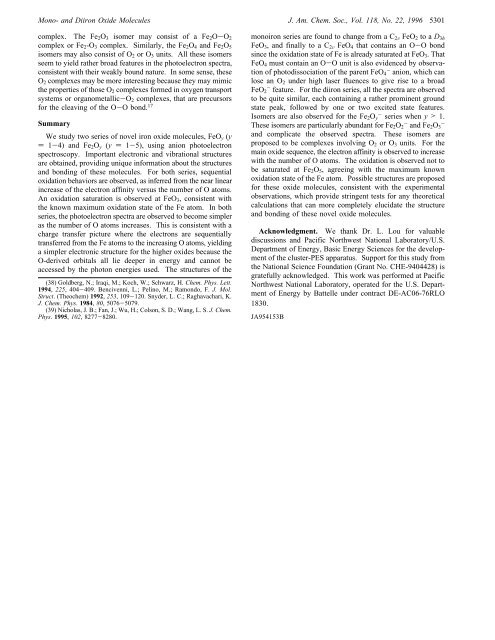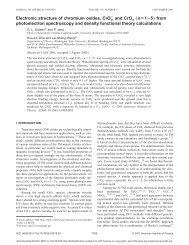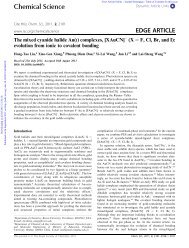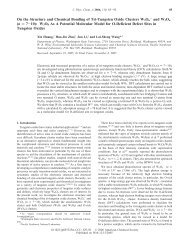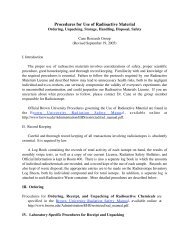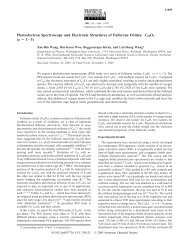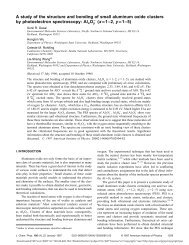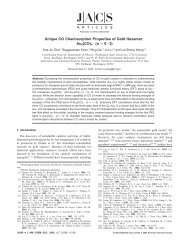Observation and Photoelectron Spectroscopic Study of Novel Mono ...
Observation and Photoelectron Spectroscopic Study of Novel Mono ...
Observation and Photoelectron Spectroscopic Study of Novel Mono ...
Create successful ePaper yourself
Turn your PDF publications into a flip-book with our unique Google optimized e-Paper software.
<strong>Mono</strong>- <strong>and</strong> Diiron Oxide Molecules J. Am. Chem. Soc., Vol. 118, No. 22, 1996 5301complex. The Fe 2 O 3 isomer may consist <strong>of</strong> a Fe 2 O-O 2complex or Fe 2 -O 3 complex. Similarly, the Fe 2 O 4 <strong>and</strong> Fe 2 O 5isomers may also consist <strong>of</strong> O 2 or O 3 units. All these isomersseem to yield rather broad features in the photoelectron spectra,consistent with their weakly bound nature. In some sense, theseO 2 complexes may be more interesting because they may mimicthe properties <strong>of</strong> those O 2 complexes formed in oxygen transportsystems or organometallic-O 2 complexes, that are precursorsfor the cleaving <strong>of</strong> the O-O bond. 17SummaryWe study two series <strong>of</strong> novel iron oxide molecules, FeO y (y) 1-4) <strong>and</strong> Fe 2 O y (y ) 1-5), using anion photoelectronspectroscopy. Important electronic <strong>and</strong> vibrational structuresare obtained, providing unique information about the structures<strong>and</strong> bonding <strong>of</strong> these molecules. For both series, sequentialoxidation behaviors are observed, as inferred from the near linearincrease <strong>of</strong> the electron affinity versus the number <strong>of</strong> O atoms.An oxidation saturation is observed at FeO 3 , consistent withthe known maximum oxidation state <strong>of</strong> the Fe atom. In bothseries, the photoelectron spectra are observed to become simpleras the number <strong>of</strong> O atoms increases. This is consistent with acharge transfer picture where the electrons are sequentiallytransferred from the Fe atoms to the increasing O atoms, yieldinga simpler electronic structure for the higher oxides because theO-derived orbitals all lie deeper in energy <strong>and</strong> cannot beaccessed by the photon energies used. The structures <strong>of</strong> the(38) Goldberg, N.; Iraqi, M.; Koch, W.; Schwarz, H. Chem. Phys. Lett.1994, 225, 404-409. Bencivenni, L.; Pelino, M.; Ramondo, F. J. Mol.Struct. (Theochem) 1992, 253, 109-120. Snyder, L. C.; Raghavachari, K.J. Chem. Phys. 1984, 80, 5076-5079.(39) Nicholas, J. B.; Fan, J.; Wu, H.; Colson, S. D.; Wang, L. S. J. Chem.Phys. 1995, 102, 8277-8280.monoiron series are found to change from a C 2V FeO 2 to a D 3hFeO 3 , <strong>and</strong> finally to a C 2V FeO 4 that contains an O-O bondsince the oxidation state <strong>of</strong> Fe is already saturated at FeO 3 . ThatFeO 4 must contain an O-O unit is also evidenced by observation<strong>of</strong> photodissociation <strong>of</strong> the parent FeO - 4 anion, which canlose an O 2 under high laser fluences to give rise to a broadFeO - 2 feature. For the diiron series, all the spectra are observedto be quite similar, each containing a rather prominent groundstate peak, followed by one or two excited state features.Isomers are also observed for the Fe 2 O - y series when y > 1.These isomers are particularly abundant for Fe 2 O - 2 <strong>and</strong> Fe 2 O- 3<strong>and</strong> complicate the observed spectra. These isomers areproposed to be complexes involving O 2 or O 3 units. For themain oxide sequence, the electron affinity is observed to increasewith the number <strong>of</strong> O atoms. The oxidation is observed not tobe saturated at Fe 2 O 5 , agreeing with the maximum knownoxidation state <strong>of</strong> the Fe atom. Possible structures are proposedfor these oxide molecules, consistent with the experimentalobservations, which provide stringent tests for any theoreticalcalculations that can more completely elucidate the structure<strong>and</strong> bonding <strong>of</strong> these novel oxide molecules.Acknowledgment. We thank Dr. L. Lou for valuablediscussions <strong>and</strong> Pacific Northwest National Laboratory/U.S.Department <strong>of</strong> Energy, Basic Energy Sciences for the development<strong>of</strong> the cluster-PES apparatus. Support for this study fromthe National Science Foundation (Grant No. CHE-9404428) isgratefully acknowledged. This work was performed at PacificNorthwest National Laboratory, operated for the U.S. Department<strong>of</strong> Energy by Battelle under contract DE-AC06-76RLO1830.JA954153B


